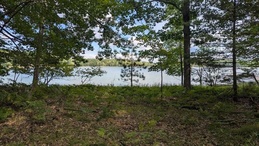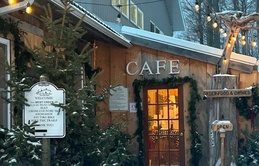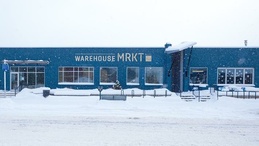
Superior Shipwrecks
The science and stories behind ships lost to the largest of the Great Lakes
By Jillian Manning | July 13, 2024
Shipwreck hunting is a unique mix of “boredom” and “incredible feats” of discovery, according to Corey Adkins.
Adkins is the communications and content director at the Great Lakes Shipwreck Historical Society (GLSHS). As we talk, he’s on his way to Whitefish Point, home of the Great Lakes Shipwreck Museum, where the GLSHS research vessel is out on the water.
That vessel, the David Boyd, measures 47 feet long and totes along dual frequency side-scan sonar equipment and a Remotely Operated Underwater Vehicle (ROV) capable of diving to depths of 1,400 feet, both of which help find and identify Lake Superior shipwrecks.
“There are 550 confirmed shipwrecks” in Lake Superior, Adkins says, “and 200 of them are right out our back door at Whitefish Point. Back in the day, they called [the stretch of water] from Whitefish Point to Munising the Graveyard of the Great Lakes or Shipwreck Coast.”
Still Waters Run Deep
During the heyday of Great Lakes shipping, there was no radar, and most ships had to rely on lighthouses and their own eyes and ears to navigate safely. Winter ice, unpredictable storms, and heavy fog all contributed to the dangers of transporting cargo through the waterways. Hundreds of ships are still waiting in the depths to be found and identified, and that’s part of the job of the GLSHS.
With so many wrecks out there, they should be easy to find, right? Well, consider that Lake Superior is the largest freshwater lake in the world by surface area and the third largest by volume. It also measures roughly 1,332 deep—just a fraction of the depth of where the Titanic lies but far deeper than Lake Michigan’s 925 feet.
That’s where the sonar—and the aforementioned boredom—come into play. Darryl Ertel, GLSHS director of marine operations, takes the Boyd out to tow their sonar in 40-mile grids, hoping to see something pop up.
“He’ll go up 40 miles one way, turn around and go 40 miles the other way, and what he does is he finds where the shipwrecks are not,” Adkins explains. “Until he sees a blip on the sonar. And then he’ll turn back around and then narrow in on that sonar beam, and then see if it’s a shipwreck or not. And you can tell if they’re shipwrecks—they’re very apparent.”
Adkins says that GLSHS has a list that includes many of the commercial vessels that went under in Lake Superior over the centuries, so even though the roster is long, they have a general location or physical details about the ship and its cargo. Of course, finding a name board on the ship helps—which does sometimes happen—but other times more research is needed.
The Adella Shores
For example, earlier this year, GLSHS announced the discovery of the Adella Shores, a 195-foot, 735-ton wooden steamer that “went missing” in Lake Superior on May 1, 1909—meaning it vanished with no survivors and no witnesses.
The ship had been on its way to Duluth, Minnesota, carrying a load of salt and following the steel steamship Daniel J. Morrell through thick ice and strong northeast winds. The Shores fell behind and disappeared along with all 14 crew members.
The wreck was first found three years ago—112 years after its sinking—by Ertel and his brother while running one of those routine grids. Adkins says features like length—the Adella Shores was bigger than most wooden schooners of the era—helped identify the ship.
“I pretty much knew that it had to be the Adella Shores when I measured the length of it, because there were no other ships out there measuring in that size range,” Ertel commented in a press release issued by GLSHS. “As soon as I put the ROV down on it for the first time, I could see the design of the ship and I could match it right up to the Adella Shores.”
Submerged Stories
The ROV can drop hundreds of feet in minutes, and Adkins says they’ve been finding “very, very deep wrecks” at 600, 700, and even 850 feet—depths that divers can’t safely dive. The ROV is essentially an underwater drone and can be used to explore and take photos of wrecks.
The one thing it can’t do? Bring anything back up to the surface.
“There’s a bottomland agreement where you’re not allowed to take anything off the bottomland of the Great Lakes around Michigan,” Adkins explains. (We asked if this would include literal treasure chests, and the answer is still yes.)
“That agreement happened because people were looting these wrecks and taking the wheels and the bells and this and that,” he continues. “In many respects, these are gravesites. You know those signs when you walk into a park that say, ‘take only pictures, leave only footprints?’ That’s kind of what we do. But we have the story, and we can tell the world about it.”
Thanks to modern technology and a dwindling list of missing ships, shipwreck discoveries are becoming more common. Adkins says in 2021 alone, GLSHS found 10 ships in a “banner year.” But the stories are meted out as the months go by, in part so that the GLSHS can explore and research the wrecks, and in part to make sure the stories of those ships rise to the surface.
“If we would have [announced] all 10 at once, the stories will get lost,” Adkins says. “We take every single one of these stories very seriously, because it’s part of history and people died on many of these wrecks. We want to remember all the sailors—men and women—that have gone down on these ships. And there’s plenty of stories out there, and they deserve to be told.”
The Arlington
Another such story was released by GLSHS in February. The Arlington, a 244-foot bulk carrier filled with wheat, had sunk 35 miles north of the Keweenaw Peninsula. (Also on May 1, this time in 1940…maybe stay on land on May Day.)
Like the Adella Shores, it had been sailing with another ship, the freighter the Collingwood, and when the Arlington began to take on water, the crew abandoned ship and made it safely to the other vessel. Except, that is, for Captain Frederick “Tatey Bug” Burke, who went down with the ship, even though he too could have gotten to safety. His behavior remains a mystery.
The Arlington was found in 2023 by shipwreck researcher Dan Fountain—who noticed the original anomaly in the lakebed—along with the GLSHS crew aboard the David Boyd.
Even though these wrecks sit under water for decades or even well over a century, Adkins says they stay “incredibly well preserved” thanks to the cold waters of Lake Superior. One of the unique features of the Arlington that survived the sinking is its double wheel, something Adkins says he hadn’t seen before.
Other items in the “debris field” from wrecks can range from deck boards to dishware to flare guns to even old toilets. Portholes and doors can stay intact, allowing the ROV to peer inside into the past.
But whether all the wrecks and their treasures are ever found, Adkins says the experience of shipwreck hunting—and the opportunity to learn about the region’s history at the Great Lakes Shipwreck Museum—is reward enough.
“When you come visit, take in the stories, the history, talk to us,” he encourages. “Go walk the beach and imagine what some of these sailors were going through.”
The Great Lakes Shipwreck Historical Society received the “Superior Award” from the Historical Society of Michigan this June, acknowledging GLSHS’s role in preserving and advancing U.P. history. Visit the Great Lakes Shipwreck Museum at 18335 N. Whitefish Point Road in Paradise. To learn more about their research and historical work, go to shipwreckmuseum.com.
Trending

Welcoming the Winter Solstice: Rituals & Events for the Shortest Day of the Year
With the winter solstice quickly approaching, it’s hard not to notice how dark each day feels. Astronomically, this is… Read More >>
Camp Greilick Now Open!
It’s been a long road for the century-old Camp Greilick, which, after several dormant years, was acquired by Grand Tra… Read More >>
Men and Ugly Sweaters
Those two things don’t always go together, but on Dec. 19, you’ll see both out and about in Petoskey and Harbor … Read More >>


